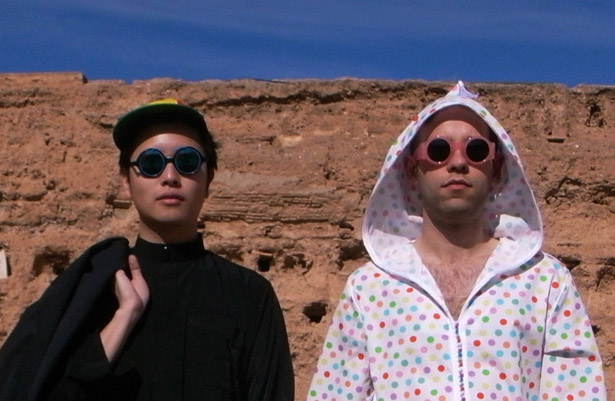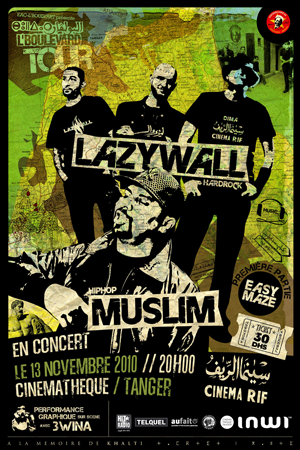When it comes to staging biennials, context and provenance can always be reduced to two questions: why here and why now? It is a post-institutional, post-global condition which the spectator/consumer must actively entertain. But, if Diedrich Diederichsen argues that the work of art openly in need of legitimation is in fact what keeps discourse alive, then perhaps the same can be said for the international art biennial.
It’s not hard to understand why there might be such a large-scale exhibition in Marrakech. Although not a stop on the 19th-century grand tour, the city has been a hub for the Francophone jetset since at least the 1950s. The ashes of Yves Saint Laurent are scattered in an ornamental garden in the nouvelle ville and both Sarkozy and Strauss-Kahn have vacation homes here. Where land and cheap labour are available and easily converted into hotels and tourism, there might as well be contemporary art – why not? At one point during the dense programme of panel discussions last week, Bidoun editor Negar Azimi shrewdly name-checked the title of Liam Gillick’s essay ‘Contemporary Art Does Not Account for That Which Is Taking Place’.
For its fourth edition, the Marrakech Biennale this year tapped two curators embedded in their respective scenes in Berlin and London, which guaranteed the participation of a number of younger artists who might be skipped over by the traditional European biennial circuit. This generated palpable excitement and ensured that many of the art works presented were special commissions produced for the occasion in Morocco. Canadian Carson Chan and British Nadim Samman attempted a refreshingly provocative position amidst a somewhat fraught context – the exhibition opened in the wake of the first anniversary of the 20th February demonstrations, Morocco’s own downscaled version of the Arab Spring – by explicitly acknowledging their position as outsiders and seeking to deliver a spectacular, populist exhibition rather than falsely assuming an ‘Arabocentric approach’.
In a city with little arts infrastructure and even less cultural funding, and with a functioning Medina also commemorated as a UNESCO world heritage site, this proved tricky and at times awkward. A slightly misguided Reader populated with academic texts expiating claims of essential difference was criticized for being published in only two languages, French and English; more worryingly, it undermined the very notion of naïveté by providing too much information in the shape of pre-emptive cultural theory. It also had very little to do with the art works displayed, which were for the most part immersive installations.
The biennial’s main venue, the half-finished Théâtre Royal, stands opposite to the city’s main train station, in the Gueliz district. Its elaborate portico and Egyptian Art Deco foyer (designed by Tunisian architect Charles Boccara) masks an unfinished interior; poured concrete and protruding rebar provide an architectonic sense of stage and multi-layered seating that is uncannily cavernous. Apparently commissioned by Hassan II after seeing the opera in Paris in the 1960s, the building can be read as a sad monument to Western cultural elitism – with little money and no Maghrebi opera company its prospects were exceedingly slender.
Installed on the grounds and within the confines of this theatre, a number of the art works take advantage of the building’s morphological structure and feckless cultural history to critical effect, by emphasizing the theatricalized mediation of experience at various scales. Moroccan artist Faouzi Laatiris’s Rosace N˚2 (2012) comprises stacks of mint tea-glasses and mirrored surfaces in precarious layers of kaleidoscopic array beneath an open sky, producing a sense of optical fragility with economized resources. In the chamber opposite, Ethan Hayes Chute’s Built-Up Site/Settled Down (2012) – a full-size cabin outfitted with hand-made furniture, kitsch trinkets and grimy paperbacks seemingly materialized from the back woods of Maine – pays tribute to the American artist’s staunch geographical self-identity. Towering in the double-height space leading to the amphitheatre, the Canadian duo Hadley + Maxwell stage an elaborate multimedia installation from scaffolding, neon and artisanal punched-metal light sources for Skies of the Heart (2012). Projecting four female voices at an unprecedented height, with 14th-century lyrics intoned by the likes of Sandra Hrabluik, Etel Adnan and the electroclash singer Peaches, its post-punk framework would not have seemed out of place in a Kreuzberg nightclub. Elsewhere, playing against postcolonial preconceptions, composer Christopher Mayo’s Anser anser (2012) consists of an atonal deconstruction of the musical phrase from Hitchcock’s The Man Who Knew Too Much (1956) when the actress Doris Day remarks, casually: ‘This isn’t really Africa. It’s the French Morocco.’
The sheer amount of exuberant work and its often introspective treatment of context was, despite best intentions, difficult to navigate without titles, wall texts or other framing devices. This made viewing (let alone apprehending) the exhibition as a whole a complex feat. A majority of biennial artists gestured with or worked within the language of contemporary art production as negotiated from the global ‘centre’ – though not necessarily portraying particularized geopolitical contexts or frameworks – which made the almost fetishized, flimsy desire for ahistorical transcendent experience quite dubious, and left other artworks to fall flat for lack of ready interpretation. In this light, Eva Grubinger’s snaking, retractable barrier system, Crowd (2007), positioned at the entrance to the theatre, contained a darker statement on cultural access. And a small collective of unrepentant artists working under the name جماعة (loosely translated as ‘together’) not only enforced the printing of the single Arabic word to appear in biennial literature through their participation, but also plastered translations culled from the reader onto the public-facing exterior of the theatre building in a still more literal attempt to encourage local engagement with the biennial’s inevitable politics.
As anyone who has worked in an institutional environment is aware, productive misinterpretation need not be encouraged – it happens always. Still, the selection of art works by this strangely self-contained, determinist rubric was involuntarily sensitive to the shifting tide of image circulation as experienced through recent protests in the Arab world and to a lesser extent North America. This was developed in a panel discussion between Beirut-based curator Rasha Salti and theorist W.J.T. Mitchell. That the aesthetics of political protest should not be instrumentalized, or rather consumed, for (art) market purposes was a topic of sincere concern, and a parade of iconic images analyzed by power-point included Delacroix’s Liberty Leading the People (1830), which was completed – perhaps ironically – just prior to the painter’s diplomatic deployment to North Africa. Curated by Casablanca-born poet and translator Omar Berrada, the pitch of the biennial conversations often reached confrontational levels: at one point an audience member challenged Berrada’s political commitments for participating in events officially sanctioned by King Mohamed VI. That the ideological emptiness of such an endorsement (received the day before the opening) was lost on an individual better accustomed to the bureaucracies of the Western university classroom than to the stopgaps of developing world dynamics was yet another performance of the biennial’s privileged audience demographics.
The two most poetic contributions to the exhibition, then, exposed the potential for mistranslation in the purportedly democratic mediation of cultural production. Located in between palm trees and public wifi hot spots in the Moulay Abdeslam Cyber Park, Aleksandra Domanović’s Monument to Revolution (2012), an abstract geometric fist emerging from the ground to a height of more than four metres, is modelled on a Serbian sculpture designed by a sympathetic artist-architect at Tito’s behest, which can be found abandoned to the political landscape of the former Yugoslavia – a once-commanding symbol now almost completely evacuated of meaning. In transporting, or essentially copy-and-pasting, this futuristic artefact to another possibly unstable context, Domanović’s monument underwent accidental modification via the physical enactment of symbolic misappropriation (often enough the result of image proliferation by means of the Internet). Produced according to specifications in Morocco, the sculpture’s fist was flattened almost beyond recognition. On a smaller scale, Katia Kameli’s film-based work, The Storyteller (2012) was shot and projected in an unfinished box-seat in the Théâtre Royal. Featuring a local storyteller typically in residence in the main square Jemaa el Fna, his more or less official occupation is to transform popular Bollywood films into the Arabic oral tradition, thereby expanding the audience for this cinema at the same time as competitively offering cut-rate prices. Naturally, a host of plot details might be lost or reinvented through retelling; cut together with footage from the film simultaneously being described, Kameli’s piece cycles through both French- and English-subtitled loops, her subject continuously narrating the adventures of two young boys who busk their way to fortune, ceaselessly coming full circle in layered explication.
Of course not all contemporary artists or art works seek to engage (political) reality; but treating the space of the biennial as a uniquely Utopian oasis cultivates its own set of problems – especially as the administrative structures of even the most conservative exhibitions stir controversy, including the current Whitney Biennial. It will be fascinating to see whether the Marrakech Biennale can maintain a level of criticality which this year’s effort indicated might well be possible, without merely engineering the economic buzz and cultural prestige which slip so easily into neoliberal agendas.
morocco culture,moroccan food,morocco food,moroccan cuisine,morocco beaches,moroccan meal,beaches in morocco,moroccan culture,hercules cave,hercules cave morocco






























